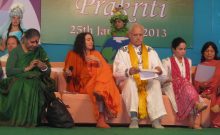Since we have come to India to participate in the largest spiritual gathering on earth ( over 70 million estimated), I am questioning here what it means to choose spirituality as a focus for one’s life. I have the rare opportunity to learn and compare two traditions: the Wiccan and the Vedic. The Wiccan tradition goes back 14,000 years, its origins lost in the hazy mists of ancient history. Related to the Isis tradition of Egypt, it is based in the worship of the Goddess, the Mother of us all, the creative and fertile force that gives rise to all life. Nature is seen as sacred as it represents many truths if we can learn to become deeply observant. Knowledge is passed down in an oral tradition because of the awareness that once wisdom is written in a book, the potential exists for misinterpretation. As long as there is a teacher, misunderstandings can be corrected. So wisdom is passed down in story form. As a priest and wisdom keeper of the tradition, Patrick McCollum is a teller of stories. Here is a lovely one he shared over tea this morning. “Our tradition sees human diversity as sacred. Imagine a stained glass window in lofty Gothic cathedral. There are many beautiful colors but the same white light shines through them all. Should one pane be broken, the beauty will be lost, and the channels of black lead holding the colors together are most critical. So it is with humanity. We are all so different, and in our different ways, we each contribute to the beauty. Once we begin to insist that people be only one certain way, have only certain beliefs and practices, we have lost the essence of truth. Each person’s journey is unique and sacred. I can share a story, but you must hear it as your own.“
For Patrick, cultural and religious diversity is as essential to our future as is biological diversity to the development of new crops and compounds for scientists. To quote him again, “ My work is to weave the various religious traditions into a fabric that is strong enough to catch the wind. All the threads are necessary and must be strong for the fabric to be able to catch the wind and move us along. Our question must be, how does each thread play its part in the whole, not who is right and who is wrong.” Given that one out of seven countries in the world is experiencing conflict in which religion plays a part, or dealing with those displaced by such conflict, his message seems very relevant.
Now to reflect on the Vedic tradition, as expressed in the life of Pujya Swami Saraswati, the head of Parmarth Ashram in Rishikesh. (Saraswati is the Goddess of knowledge and music.) He has founded the Ganga Action Parivar to protect the Ganges River through clean-up, forest planting, education and conservation. Known as a Sacred Activist, he is seen as a renegade in his tradition. Unlike those who are content to practice their sadhana, or spiritual practice, in pursuit of enlightenment, he sees the purpose of prayer, meditation, yoga, rituals as becoming more capable of performing God’s work on Earth. So, before he led us in the ritual bathing in the river, he led us in cleaning up the trash that had accumulated on the banks. We were quite a sight: Manouso Manos, one of the best known yoga teachers in America, in his underwear, sloshing behind the Swami, scooping up plastic bags entwined with marigold garlands. This is unthinkable in traditional Indian culture, for respected individuals to be picking up filthy trash; rather, this would be the work of untouchables, of the poorest of the poor.
So the two traditions have the obvious similarities of the use of fire and water in ceremonies, and the sense of sacred place. But what is remarkable to me is that these two men from such different religious backgrounds found themselves cleaning the river banks with the same passion for caring for what they see as sacred: Mother Earth.
Harriet Nettles


Leave a Comment